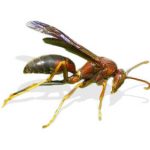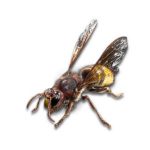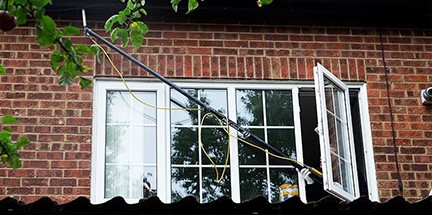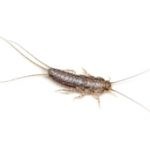Wasp Facts
We will take a look at one of the deadliest vermin in the UK – wasps. People usually associate stinging insects with bees, but wasps cause 200% more death cases than their honey-making cousins. We’ll tell you all about wasp facts, what attracts wasps to your home and 6 tips on how to avoid wasp stings.
Facts About Wasps
Appearance
Many people find it hard to differentiate yellow jackets — the most common wasp species in Britain, from bees. It is extremely important to be able to tell the difference between both.
Wasps in the UK are coloured in bright yellow and shiny black and lack the distinct “hair” of bees. Their bodies are larger, slender and slicker. They have a narrow waist that connects the two segments. In-flight, wasps leave their back pair of legs hanging in a specific manner.
Feeding habits and life cycle
Yellowjackets live in colonies and hunt in packs. Each year the colony is re-established and can quickly reach its maximum size of 5,000 to 6,000 specimens in spring, and up to 20,000 in summer. Almost all wasps people encounter are female as males are used only to fertilise the wasp queen.
All wasps are hunters and scavengers. They collect caterpillars for their larvae and feed on rotting and fresh sweet fruits, nectar and even meat. They are also attracted by carrions and offals. Some wasp species can even make honey.
Wasp nests
The majority of wasps that can be found around the UK are social wasps. This means that they live in nests.
A wasp’s nest is constructed of chewed wood and plant fibres which are bonded by the wasp’s saliva. The wasp’s nest is home to worker wasps, male drones and a single egg-carrying queen. Most wasp nests die off with the drop of temperatures in autumn but some may survive if the weather conditions are favourable and the nest is located in a dry place close to a food source.
Stings and bites
Unlike bees, wasps can sting numerous times without experiencing any harm. Their stings are dangerous as they inject venom into your body. Around 10% of people are allergic to this venom. It’s crucial to learn how to avoid wasp stings as the stings cause swelling, redness, lymph nodes inflammation and rarely rashes.
The venom injected with the sting breaks down cell membranes, which causes us to experience extreme pain. Allergic people develop a symptom that is known as “large local reaction”. This reaction is associated with increased swelling and a prolonged recovery period. Multiple stings can cause severe damage to both allergic and non-allergic individuals.
Wasps have powerful mandibles which they do use to bite humans. Although wasp bites are not venomous and are unlikely to kick off an allergic reaction, they are painful enough on their own. Wasps are powerful enough to bite off small chunks of skin.
Need wasp treatment?
Book local wasp exterminator with a single call!
Call us
How to avoid wasp stings?
- Leave the area where the wasp is hovering, if given the chance.
- Don’t run or attempt to swat the wasp.
- Don’t spray insecticide on a wasp you are stuck in a room with. Dying wasps use stinging as a last resort of defence, so you are likely to increase the chances of getting stung.
- Instead, trap the wasp against a window with the use of glass. Turn off the lights and cover the food, so that the wasp will be naturally attracted to the light coming from the window.
- Avoid fragrances such as aftershave, perfume, scented suncream and deodorants when having a picnic.
- Bring a mint plant instead of flowers with you when eating outside. Wasps will most likely be repelled by it.
Bonus: Wasps are territorial so if you place a fake wasp nest on your yard, they will avoid your property.
Treatment of wasp stings
Wasp stings should be treated immediately to prevent a large local reaction. A popular and efficient DIY method is to rub fresh garlic onto the wound. You can also apply a cold pack to it to reduce the swelling and pain. Also, keep the stung area clean and disinfect it once a day until the inflammation disappears. In case you continue to experience severe pain, consult your MD for the need for medication.
Although painful, wasp bites do not need to be treated.
Effective wasp control service
Rely on professional assistance against the vermin!
Call us
Types of Wasps in the UK
Wasps come in many shapes and sizes, and knowing what you’re dealing with can make all the difference when it comes to safety. So, let’s explore some of the types of wasps in the UK:
German wasps (Vespula germanica)
 They are the most common species of wasps in the UK and the first association of most people when they hear that word. They attack in swarms without warning and can chase their prey up to a few hundred metres. They have a great sense of smell which allows them to ruin your outdoor summer picnic. German wasps reach 18mm in length.
They are the most common species of wasps in the UK and the first association of most people when they hear that word. They attack in swarms without warning and can chase their prey up to a few hundred metres. They have a great sense of smell which allows them to ruin your outdoor summer picnic. German wasps reach 18mm in length.
Image by: Juan Emilio
Red wasps (Polistes carolina)
 They are closely related to German wasps but prefer to live outside rural regions. They stray from human settlements and can be easily found in nature—especially in forested areas. They construct their nests underground which makes them extremely dangerous for hikers. If a person steps on the entrance of a red wasp nest, the hive will perceive him as a threat, become aggravated and attack him immediately.
They are closely related to German wasps but prefer to live outside rural regions. They stray from human settlements and can be easily found in nature—especially in forested areas. They construct their nests underground which makes them extremely dangerous for hikers. If a person steps on the entrance of a red wasp nest, the hive will perceive him as a threat, become aggravated and attack him immediately.
Image by: David Hill
European hornets (Vespa crabro)
 They are the only type of hornets in the UK. Their stings are much more painful and venomous than the stings of other wasp species. They are also larger in size and can reach up to 40mm—as large as a human thumb. Thankfully, they are quite rare in Britain and their hives are smaller in size.
They are the only type of hornets in the UK. Their stings are much more painful and venomous than the stings of other wasp species. They are also larger in size and can reach up to 40mm—as large as a human thumb. Thankfully, they are quite rare in Britain and their hives are smaller in size.
Image by: Didier Descouens
Will wasps leave on their own?
Depending on the season and how near the end of their life cycle they are, wasps may decide to leave on their own.
Usually, the most common wasp species in the UK become active in the summer and begin nesting in the spring. The colony dies out in autumn when the queen leaves to hibernate and the nest is unattended. They may therefore leave on their own in a month or two if the nest is not providing an urgent threat, and late in the season.
However, if it’s spring or summer, they’re likely to stick around, and the colony will continue growing. It’s advisable not to ignore the nest if it’s in an inconvenient place, like next to a door, in the attic, or a wall hollow. When food becomes scarce later in the season, wasps might become violent.
What to do in case of a wasp infestation
 We cannot stress this enough—immediately seek professional help. We’ve mentioned it several times already—wasps become easily aggravated and will attack without warning. Wasp stings are venomous and lead to 200% more death cases annually than bees.
We cannot stress this enough—immediately seek professional help. We’ve mentioned it several times already—wasps become easily aggravated and will attack without warning. Wasp stings are venomous and lead to 200% more death cases annually than bees.
Wasp nest removal is a delicate task that requires professional experience and equipment. Do not attempt by yourself.
Disclaimer
Keep in mind that we only aim to provide some useful information about wasps in general. We cannot guarantee that the insects you’re dealing with corresponds to the same description and are exactly the same.
Read more



 They are the most common species of wasps in the UK and the first association of most people when they hear that word. They attack in swarms without warning and can chase their prey up to a few hundred metres. They have a great sense of smell which allows them to ruin your outdoor summer picnic. German wasps reach 18mm in length.
They are the most common species of wasps in the UK and the first association of most people when they hear that word. They attack in swarms without warning and can chase their prey up to a few hundred metres. They have a great sense of smell which allows them to ruin your outdoor summer picnic. German wasps reach 18mm in length. They are closely related to German wasps but prefer to live outside rural regions. They stray from human settlements and can be easily found in nature—especially in forested areas. They construct their nests underground which makes them extremely dangerous for hikers. If a person steps on the entrance of a red wasp nest, the hive will perceive him as a threat, become aggravated and attack him immediately.
They are closely related to German wasps but prefer to live outside rural regions. They stray from human settlements and can be easily found in nature—especially in forested areas. They construct their nests underground which makes them extremely dangerous for hikers. If a person steps on the entrance of a red wasp nest, the hive will perceive him as a threat, become aggravated and attack him immediately. They are the only type of hornets in the UK. Their stings are much more painful and venomous than the stings of other wasp species. They are also larger in size and can reach up to 40mm—as large as a human thumb. Thankfully, they are quite rare in Britain and their hives are smaller in size.
They are the only type of hornets in the UK. Their stings are much more painful and venomous than the stings of other wasp species. They are also larger in size and can reach up to 40mm—as large as a human thumb. Thankfully, they are quite rare in Britain and their hives are smaller in size. We cannot stress this enough—immediately seek professional help. We’ve mentioned it several times already—wasps become easily aggravated and will attack without warning. Wasp stings are venomous and lead to 200% more death cases annually than bees.
We cannot stress this enough—immediately seek professional help. We’ve mentioned it several times already—wasps become easily aggravated and will attack without warning. Wasp stings are venomous and lead to 200% more death cases annually than bees.







